Attached files
| file | filename |
|---|---|
| 8-K - 8-K - HollyFrontier Corp | hfc-form8xkpresentationjan.htm |
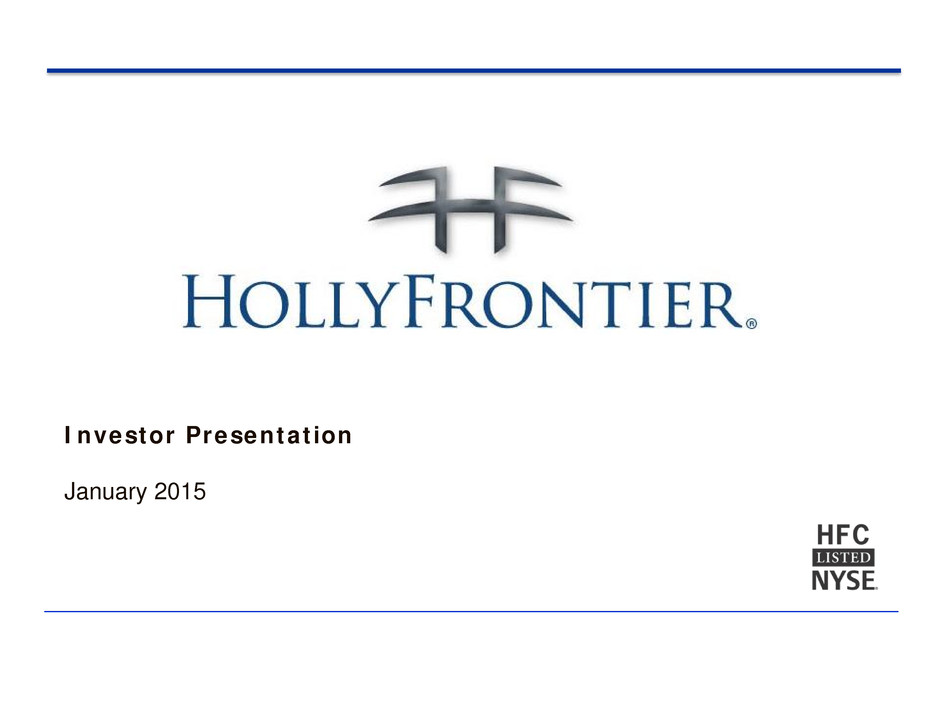
Investor Presentation January 2015
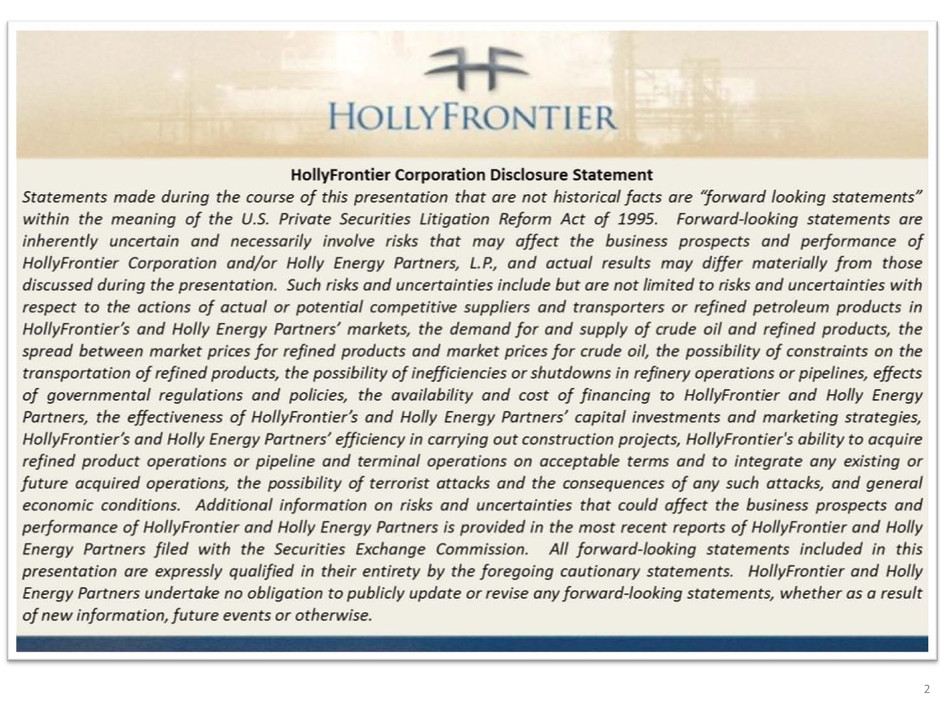
2
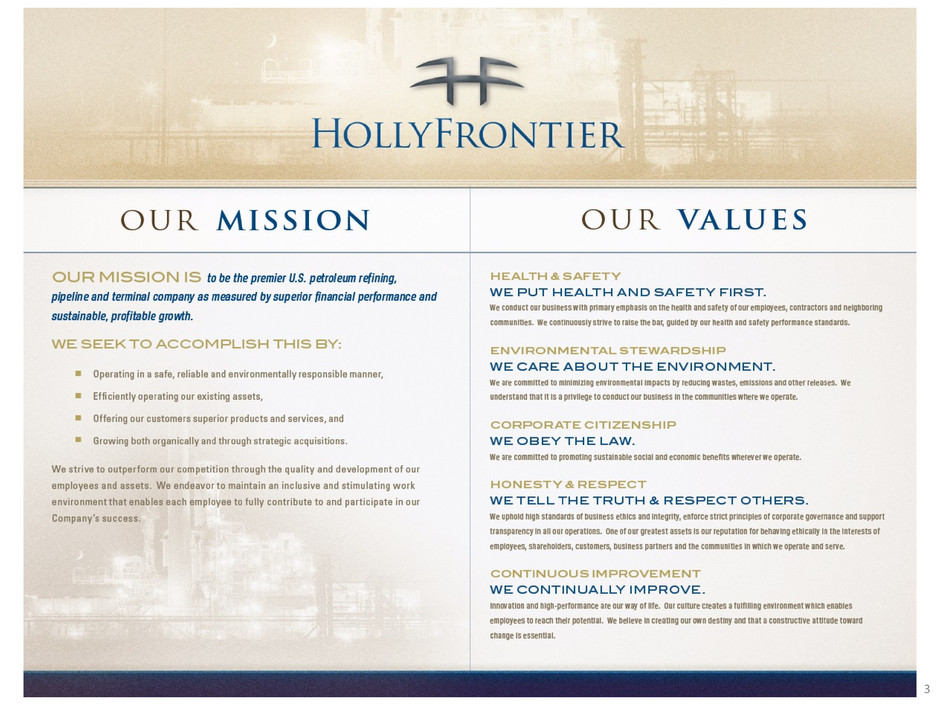
3

HollyFrontier Investment Highlights 4 Pure play competitive refinery 5 refineries with 443,000 barrels per day refining capacity Attractive niche product markets with advantaged crude supply Rocky Mountains, Southwest and Mid-Continent Strong investment track record with future growth focused on advantaged projects Woods Cross, El Dorado and Tulsa refineries purchased at industry lows on a per barrel basis Strong Financial Performance Industry leading returns on capital Best in class net income per barrel crude capacity Track record of high cash return to shareholders Strong and Liquid Balance Sheet Investment Grade Ratings from S&P and Moody’s Significant Ownership in High-Quality Logistics MLP, Holly Energy Partners Own 39% of HEP, including 2% GP interest and 37% of LP Units Have achieved high-split on GP Incentive Distribution Rights For FY2013, HFC received over $73 million in cash distributions from HEP
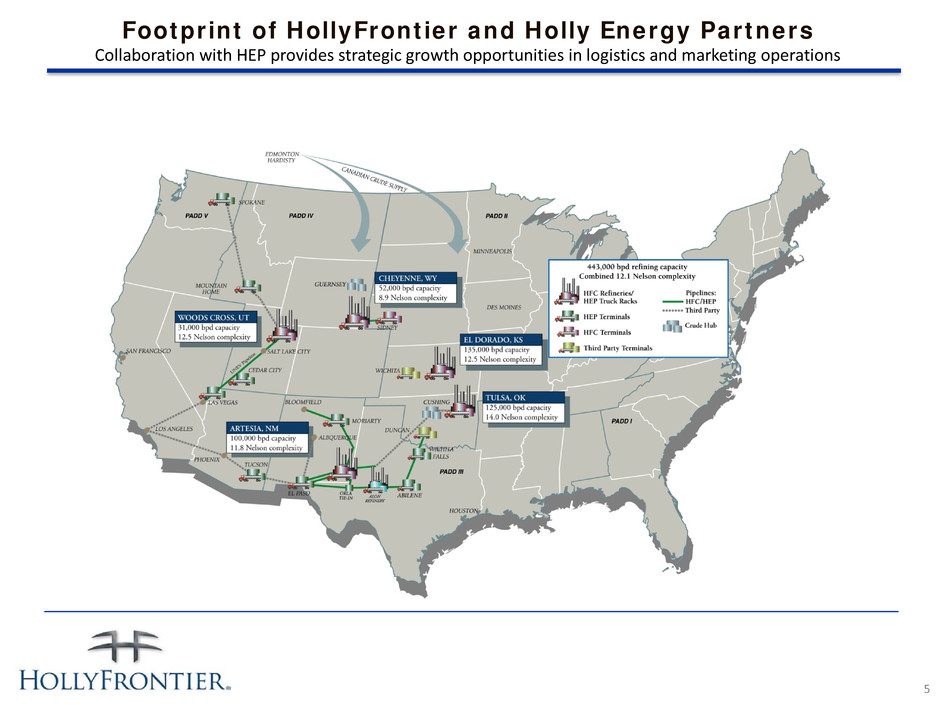
Footprint of HollyFrontier and Holly Energy Partners Collaboration with HEP provides strategic growth opportunities in logistics and marketing operations 5

Proximity to Growing North American Crude Production Refineries are well-positioned for exposure to the growing supply of lower cost domestic and Canadian crude oil 6 Sources: Citi, Deutsche Bank, Goldman Sachs, Macquarie, Simmons & Co, Canadian Association of Petroleum Producers, Turner, Mason & Co., North Dakota Pipeline Authority, and the EIA. All 5 HFC Refineries Sit Close to Production Growth Domestic Crude Production and Refining Capacity North American Production Growth Th ou sa nd B ar re ls p er d ay (mbpd) 2013 2014 2015 Canada 3,400 3,700 3,900 Bakken 800 1,200 1,300 Permian 1,300 1,500 1,800 Niobrara 225 270 300 Uinta 70 85 90 Oklahoma/Kansas 300 350 375 Total US. and Canada 11,260 12,750 13,250 Year on Year Growth +1.0mm BPD +0.5mm BPD 0 5,000 10,000 15,000 20,000 2009 2010 2011 2012 2013 2014E PADD1 PADD2 PADD3 PADD4 PADD5 Crude Production

Sensitivity determined from WTI, WTS, and WCS crude inputs multiplied by annualized crude capacity for HFC and adjusted for approximate tax expenses. The full year $/share impact is determined based on 12/31/13 shares outstanding. Based on assumption that Brent based crude sets product prices. *Data from quarterly earnings calls. 7 Advantaged Crude Slate Refinery location and configuration enables a fleet-wide crude slate discounted to WTI Discounted feeds drive higher gross margins / barrel and ultimately, EBITDA Highly flexible refining system allows feedstock optionality All HFC purchased barrels are at or below WTI price $0.09 $0.12 $0.51 $0.00 $0.10 $0.20 $0.30 $0.40 $0.50 $0.60 WCS/WTI Midland/Cushing WTI/Brent EPS Sensitivity to $1 Change in Differential* Run approximately 80,000 BPD of WCS Capacity to run in excess of 100,000 BPD of Midland priced crude -$16 -$14 -$12 -$10 -$8 -$6 -$4 -$2 $0 $2 3Q14 2Q14 1Q14 4Q13 $/ bb l d is co un t to W TI Feedstock Advantaged Refining* Rockies MidCon Southwest Consolidated

Expanding Reach in Growing Markets 8 Sources: Company research and the EIA.

Focus on Safe and Reliable Operations 9 Personal Safety Refinery Reliability Equivalent Distillation Capacity Process Availability *Data from 2H2011 following the Holly and Frontier merger Source: HFC Analysis Key Initiatives Occupational and Process Safety Management Teams Risk-based Inspection Program Operational Integrity and Training You See It, You Own It Process Safety Tier 1 Process Safety Incident Rate OSHA 300 Recordable Incident Rate 0 0.1 0.2 0.3 0.4 2011* 2012 2013 0 0.2 0.4 0.6 0.8 1 1.2 1.4 1.6 2011* 2012 2013 Employees Contractors 92% 93% 94% 95% 96% 97% 2012 2013 HFC Consolidated 2012 Industry Average

10 Investment & Acquisition Strategy • Strong track record of buying the right assets at the right time • Woods Cross, El Dorado, and Tulsa refineries all purchased at industry lows on a per barrel basis • High hurdle rate on investments and acquisitions • Target AT LEAST 2x our Cost of Capital • Focus on projects with economics secured by crude supply and/or off-take agreements • Projects focus on advantaged crude access and improving refinery liquid yield Current Growth Initiatives • Woods Cross Phase 1 Expansion – permitted, estimated completion: 4Q2015 • Expansion of Holly Energy Partners’ New Mexico Crude Gathering System: Completed • El Dorado Naphtha Fractionation – estimated completion: Spring 2015 • Tulsa FCC Revamp – estimated completion: Fall 2015 Potential Growth Initiative • Tulsa Modernization Project – permit pending • Woods Cross Phase 2 Expansion – permitted Strategic Investment & Acquisition Current and Potential Growth Initiatives

11 Strategic Investment & Acquisition Woods Cross Expansion Phase 1 Expand crude capacity from 31,000 to 45,000 barrels per day Includes relocation/revamp of FCC and polymerization units from Bloomfield, NM refinery Crude slate to include 25,000 BPD local Uinta Basin Black Wax Crude. 20,000 BPD 10-year crude supply agreement with Newfield Expected yields: 60% gasoline and 40% diesel Incremental Production to ship down the UNEV Pipeline to the Las Vegas market 3 year payback expected *Woods Cross Phase 1 expected EBITDA generation based on an assumed crack spread environment. PROJECT ESTIMATED CAPEX PROJECTED EBITDA GENERATION* EXPECTED COMPLETION Woods Cross Phase 1 $350 - $400 million $125 million Q4 2015 0 5,000 10,000 15,000 20,000 25,000 30,000 35,000 40,000 45,000 50,000 Current Phase 1 Cr ud e Ca pa ci ty ( B PD ) WX Black Wax Capacity Black Wax Total

Expand crude capacity from 45,000 to 60,000 barrels per day Includes increased crude and vacuum capacity, the installation of a Hydro Isom Unit, Hydrogen Plant and Distillate Hydrotreater Up to 50,000 BPD of local Uinta Basin Black Wax Crude capacity. Pursuing further crude supply agreements to support expansion Expected yields: 60% Group 3+ lubricants Group 3 demand growth driven by new passenger car and heavy truck motor oil specifications requiring higher quality basestock Global demand to more than double in the next decade The US currently imports 16,000 BPD from Asia, US demand forecast to grow approximately 50% to 30,000 BPD by 2022 3 year payback expected 12 Strategic Investment & Acquisition Woods Cross Expansion Phase 2 *Woods Cross Phase 2 expected EBITDA generation based on conservative Group 3 lube crack and average crude cost Sources: Citi, Company research. *Uinta Production expectation trimmed by 20% 0 10,000 20,000 30,000 40,000 50,000 60,000 70,000 Current Phase 1 Phase 2 Cr ud e Ca pa ci ty ( B PD ) Woods Cross Black Wax Capacity Black Wax Black Wax (maximum) Total PROJECT ESTIMATED CAPEX PROJECTED EBITDA GENERATION* Expected Completion Woods Cross Phase 2 $750 million to $1 billion $350 million 2018+ 0 50 100 150 200 2014 2016 2020 Black Wax Supply Demand Balance* HollyFrontier Tesoro Chevron Big West Silver Eagle Total Supply

13 Strategic Investment & Acquisition El Dorado Naphtha Fractionation PROJECT ESTIMATED CAPEX PROJECTED EBITDA GENERATION EXPECTED COMPLETION El Dorado Naphtha Fractionation $99 million $57 million Spring 2015 The Naphtha Splitter tower separates light Naphtha and Iso-pentane from the reformer and isomerization feed using them as gasoline blending components Reduces benzene in gasoline for MSAT II compliance by selecting only heavier Naphtha for reformate production Octane improvement from Isomerization unit allows reduction in severity on the Reformer with expected improvement in liquid yield by 1.25% Installation of new Hydrogen Plant using Natural Gas as a feedstock to meet Hydrogen demand 2 year payback expected * El Dorado Naphtha Fractionation expected base case EBITDA generation based on benzene credit generation and incremental gasoline production using 5 year average Group 3 gasoline cracks
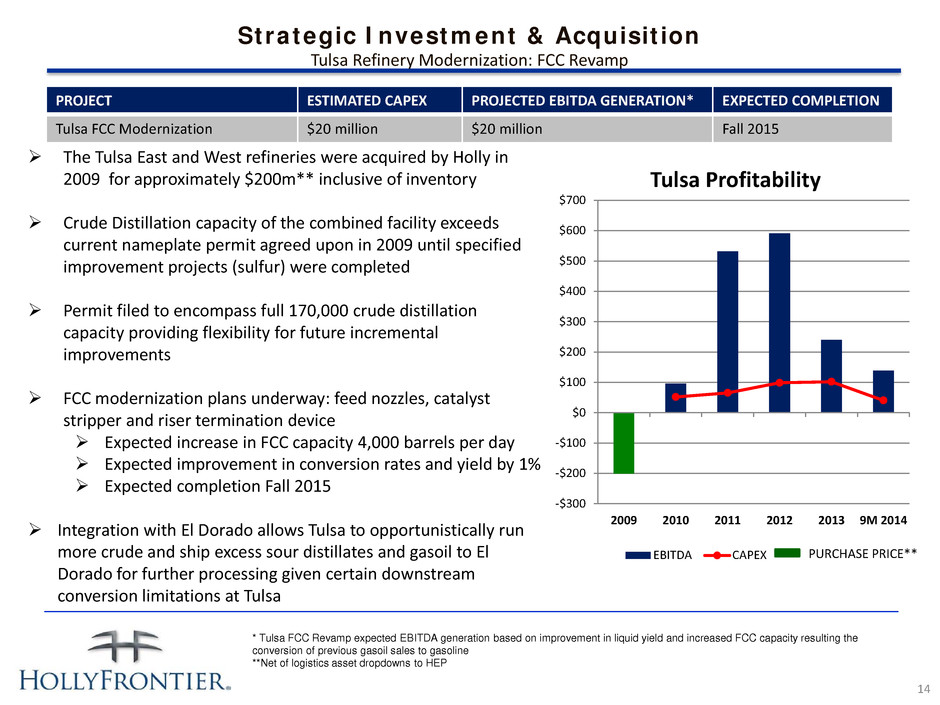
-$300 -$200 -$100 $0 $100 $200 $300 $400 $500 $600 $700 2009 2010 2011 2012 2013 9M 2014 Tulsa Profitability EBITDA CAPEX 14 Strategic Investment & Acquisition Tulsa Refinery Modernization: FCC Revamp PROJECT ESTIMATED CAPEX PROJECTED EBITDA GENERATION* EXPECTED COMPLETION Tulsa FCC Modernization $20 million $20 million Fall 2015 * Tulsa FCC Revamp expected EBITDA generation based on improvement in liquid yield and increased FCC capacity resulting the conversion of previous gasoil sales to gasoline **Net of logistics asset dropdowns to HEP The Tulsa East and West refineries were acquired by Holly in 2009 for approximately $200m** inclusive of inventory Crude Distillation capacity of the combined facility exceeds current nameplate permit agreed upon in 2009 until specified improvement projects (sulfur) were completed Permit filed to encompass full 170,000 crude distillation capacity providing flexibility for future incremental improvements FCC modernization plans underway: feed nozzles, catalyst stripper and riser termination device Expected increase in FCC capacity 4,000 barrels per day Expected improvement in conversion rates and yield by 1% Expected completion Fall 2015 Integration with El Dorado allows Tulsa to opportunistically run more crude and ship excess sour distillates and gasoil to El Dorado for further processing given certain downstream conversion limitations at Tulsa PURCHASE PRICE**

Capital Expenditure Overview *We expect 2014 capital expenditures to total approximately $400 million, and expect to spend approximately $130 on turnarounds and tank maintenance. Legacy HOC & FTO capital expenditures combined for periods prior to the 2011 merger. 2011 capital expenditure calculated using 2011 HFC capital expenditure of $374m plus FTO capital expenditure of $42.4m for 2011 period prior to the merger. Does not include capital for HEP or turnarounds.**Approximate splits among capital expenditures. Please refer to publicly available financial statements for actuals. 15 Expenditures by Classification** Growth 30% Maintenance + Environmental 40% Turnaround 20-30% $- $100 $200 $300 $400 2010 2011 2012 2013 2014E* $272 $377 $290 $381 $400 Historical Capital Expenditure $0 $50 $100 $150 $200 2010 2011 2012 2013 2014E* $86 $53 $160 $194 $130 Historical Turnaround Costs

Strong Balance Sheet & Cash Returns 16 $1.5 billion cash on balance as of 9/30/14 $188 million outstanding debt as of 9/30/14 excludes non-recourse HEP debt Total debt to capital ratio 3% as of 9/30/14* As of 9/30/14, $468 million in share repurchase authorization Continued commitment to returning excess cash to shareholders *Excluding HEP debt which is nonrecourse Since the July 2011 merger HFC has returned approximately $2.8 billion in cash to shareholders m ill io ns 0 100 200 300 400 500 600 700 800 900 2011 2012 2013 2014 $270 $864 $825 $780 Buyback Dividend

Dividend Returns to Shareholders *Dividends are split adjusted reflecting HFC’s two-for-one stock split announced August 3, 2011. **Data from public filings and press releases. As of 12/31/2014 NYSE closing prices. See page 40 for calculations. 17 Increased regular dividend 6 times since the merger, a 325% increase Declared 15 special dividends since the merger, total of $7.50 per share 2011 Regular Special 2012 Regular Special 2013 Regular Special 2014 Regular Special Q1 $0.075 - Q1 $0.10 $0.50 Q1 $0.30 $0.50 Q1 $0.30 $0.50 Q2 $0.075 - Q2 $0.15 $0.50 Q2 $0.30 $0.50 Q2 $0.32 $0.50 $0.50 $0.50 Q4 $0.10 $0.50 Q4 $0.20 $0.50 Q4 $0.30 $0.50 Q4 $0.32 $0.50 Dividends Declared* Q3 $0.0875 $0.50 $0.15Q3 Q3 $0.30 $0.50 $0.32 $0.50Q3 0.0% 2.0% 4.0% 6.0% 8.0% 10.0% HFC WNR PBF ALJ DK PSX VLO MPC TSO 8.7% 8.2% 4.5% 4.2% 3.7% 2.6% 2.1% 2.0% 1.5% LTM Cash Yield

Best In Class Returns on Capital Employed Pro Forma HollyFrontier Returns on Invested Capital (Average 2009-2013) 5-year average ROCE calculated by taking the average of ROCE’s for the years 2009-2013. ROCE calculated as net income divided by the sum of total debt (excluding MLP debt) and total equity. For HFC, legacy HOC/FTO earnings, debt & equity were combined for 5-year calculations. See page 40 for calculations. *PBF calculated on a 4-year average ROCE from 2010 - 2013 18 -2% 0% 2% 4% 6% 8% 10% 12% 14% HFC MPC PSX DK WNR TSO VLO PBF* ALJ 13% 13% 11% 7% 6% 5% 4% 3% -1% R O CE

EV/EBITDA vs Returns on Capital Employed 5-year average ROCE calculated by taking the average of ROCE's for the years 2009-2013. ROCE calculated as net income divided by the sum of total debt and total equity. For HFC, legacy HOC/FTO earnings, debt & equity were combined for 5-year calculations. See page 40 for calculations. 19

Strong Financial Metrics vs Peers Net Income per Barrel of Crude Capacity HFC earnings per bbl strongest in peer sector (2009 – 2013) HFC earnings calculated by adding legacy HOC plus FTO earnings for periods prior to the merger. See page 40 for calculations. 20 4.76 3.66 2.92 2.00 1.42 1.18 1.11 0.15 -0.22 -$6.00 -$4.00 -$2.00 $0.00 $2.00 $4.00 $6.00 $8.00 $10.00 $12.00 HFC MPC PSX WNR DK TSO VLO PBF ALJ D ol la rs p er b ar re l 2009 2010 2011 2012 2013

Business not Built on WTI/Brent Spread Between 2001-2010, WTI traded on average at a $1.00 PREMIUM to Brent Between 2001-2010: Average ROCE 22% Average NI/BBL $2.69 -10.0% 0.0% 10.0% 20.0% 30.0% 40.0% 50.0% 2001 2002 2003 2004 2005 2006 2007 2008 2009 2010 ROCE Source: Bloomberg HFC financials calculated by adding legacy HOC plus FTO for periods prior to the merger. See page 40 for calculations. 21

Holly Energy Partners Investment Highlights 22 Well positioned assets that serve high growth markets Leverage to Permian growth through expanded Southeastern New Mexico Gathering system Successful execution of growth plan has resulted in consistent distribution increases Increased distribution every quarter since IPO Fee based revenues with no commodity risk; revenue sources include: Tariffs from pipeline movements, fees from storage, transfer and terminaling Capacity lease commitments Long Term Contracts Support Cash flow Stability Over 80% of revenues are tied to long term contracts with minimum commitments Contracts require minimum payment obligations for volume and/or revenue commitments Minimum annualized commitments produce over $270 million in HEP revenues (89% of 2013 revenues)

Holly Energy Partners Partnership Growth 23 Organic Growth Increase cash flow via logical additions to existing assets, volume growth and annual contractual PPI-related revenue growth HFC Growth Partner with HollyFrontier to grow current asset base with projects and joint acquisitions Partner with HollyFrontier in lubricants investment currently being evaluated Partner with HollyFrontier to grow non-traditional asset base Third Party Growth Acquire third party assets and/or businesses Current HEP growth initiatives Southeastern New Mexico Crude Gathering Expansion UNEV volume growth

Holly Energy Partners Expected Visible Growth With minimal incremental increase in Operating Expense, visible growth is estimated to increase HEP’s annual EBITDA run rate by >15% Expected Annual Incremental Revenue Expected Timing SE NM Crude Gathering $10 mm 2H 2014 UNEV Volume Increase via SLC Refinery Expansions $15 mm 2015 - 2016 Contractual Tariff Increases $3 - $9 mm Annually > $30 million (1) (1) Annual run-rate began September 1, 2014. (2) Estimate based on additional 15,000 bpd at incentive rate to Las Vegas plus customary terminaling revenue following Salt Lake City refinery expansions; approximately 25% of $15mm revenue run-rate is expected in 2015 with 100% expected in 2016. (3)Assumes 1-3% increase in PPI Finished Goods Index (2) (3) 24

25 Holly Energy Partners Southeastern New Mexico Crude Gathering Expansion Permian Production projected to grow from 1.5 million BPD to over 2 million BPD by 2018 Long term, bull case scenario calls for Permian Production to reach over 3 million BPD by 2025 HFC’s Navajo refinery runs 80-100% Permian Crude, the majority from the Malaga region Expect >30% production growth in this area to approximately 500,000 BPD by 2018 - 500 1,000 1,500 2,000 2,500 3,000 th ou sa nd B PD Permian Supply Demand Balance Pipeline Capacity Refining Capacity* Production - 100 200 300 400 500 600 2011 2012 2013 2014 2015 2016 2017 2018 th ou sa nd B PD Malaga Region Production Andrews Winkler Ward Loving Reeves Culberson Lea Eddy Sources: the EIA, New Mexico Bureau of Land Management, and Company research. * Assuming 90% utilization rate and projection of Permian Crudes run in each refinery
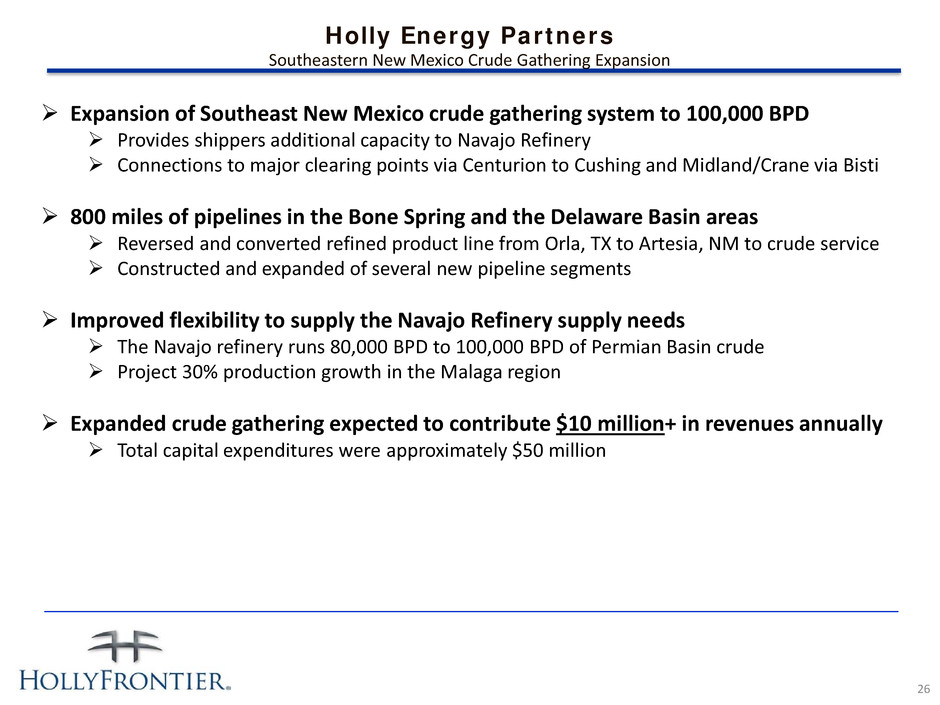
26 Expansion of Southeast New Mexico crude gathering system to 100,000 BPD Provides shippers additional capacity to Navajo Refinery Connections to major clearing points via Centurion to Cushing and Midland/Crane via Bisti 800 miles of pipelines in the Bone Spring and the Delaware Basin areas Reversed and converted refined product line from Orla, TX to Artesia, NM to crude service Constructed and expanded of several new pipeline segments Improved flexibility to supply the Navajo Refinery supply needs The Navajo refinery runs 80,000 BPD to 100,000 BPD of Permian Basin crude Project 30% production growth in the Malaga region Expanded crude gathering expected to contribute $10 million+ in revenues annually Total capital expenditures were approximately $50 million Holly Energy Partners Southeastern New Mexico Crude Gathering Expansion

Permian Demand and Takeaway 27

HEP Growth: Cash Distribution Since Inception 28 $0.0 $5.0 $10.0 $15.0 $20.0 $25.0 $30.0 2005 2006 2007 2008 2009 2010 2011 2012 2013 $0.9 $2.0 $3.1 $4.1 $8.1 $12.9 $17.5 $23.6 $29.4 $m ill io ns Total GP Distribution $0 $20 $40 $60 $80 $100 $120 $140 $160 2005 2006 2007 2008 2009 2010 2011 2012 2013 $35 $44 $49 $54 $68 $86 $99 $126 $144 $m ill io ns Total HEP Distributions (GP and LP) HFC received approximately $73mm in cash distributions for FY2013 *CAGR=Compound Annual Growth Rate

Value of HFC’s LP & GP Interests in HEP 29 *Based on a range of recent HEP unit prices on the NYSE for valuation purposes. NYSE closing price on 12/31/2014 was $29.91 Methodology: • GP values are equal to quarterly GP cash flow on an annualized basis minus the $5m GP giveback for the a period of 3 years (as part of the HEP UNEV purchase transaction) times the above range of commonly used market multiples. These values do not reflect actual after tax value to HFC. • Approximate limited partner unit value estimated using a range based on recent market price & general partner value estimated using a commonly used range of Wall Street market multiples applied to incentive distributable cash flow. These values do not reflect actual after tax value to HFC. LP INTEREST*: HEP Unit Price $28.00 $30.00 $32.00 HFC owns 22.4mm common units ($mm): $627 $672 $717 GP INTEREST: Annualized GP IDR cash flow: Annualized IDR cashflow ($mm): 35.6$ Multiple of GP cash flow: 15X 20X 25X Current GP Interest IDR Distributions ($mm): $534 $712 $890 HEP VALUE TO HFC (millions): 1,161$ 1,607$
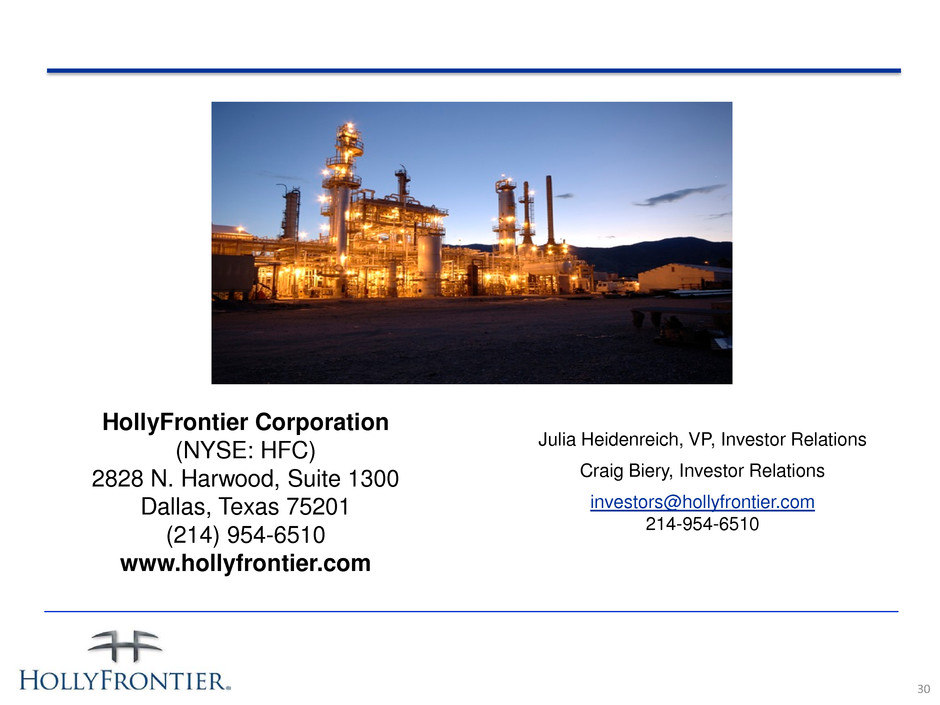
HollyFrontier Corporation (NYSE: HFC) 2828 N. Harwood, Suite 1300 Dallas, Texas 75201 (214) 954-6510 www.hollyfrontier.com Julia Heidenreich, VP, Investor Relations Craig Biery, Investor Relations investors@hollyfrontier.com 214-954-6510 30

Appendix 31

HollyFrontier Index Please see p. 42 for disclaimer and www.HollyFrontier.com/investor-relations for most current version. 32

HollyFrontier Enterprise Value 33 *As of most recent publicly available financial statements. NYSE closing price on 12/31/14 was $37.48. HFC does not have preferred shares outstanding. **Holly Energy Partners debt is non-recourse to HollyFrontier ***See p. 29 for additional details on GP and LP valuation ranges and methodology All amounts in millions except per share data Source: Bloomberg Shares Outstanding* 197 Price per Share* $37.48 Market Cap 7,384 Less: Cash* (1,479) Add: Total Debt* 1,039 Less: HEP Debt** (851) Add: Minority Interest 587 Enterprise Value 6,680 Less: HEP GP Value*** (712) Less: HEP LP Value*** (672) Implied Refining EV 5,296 2015 EBITDA: Estimate Range $900B - $1.8B 2015 EBITDA: Consensus $1.4B
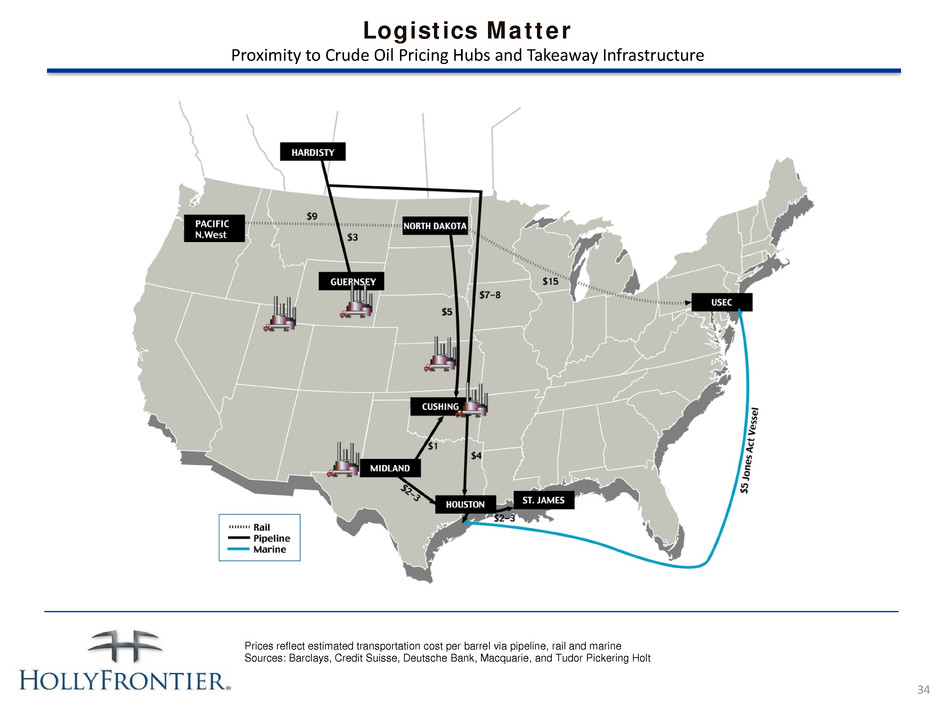
Logistics Matter Proximity to Crude Oil Pricing Hubs and Takeaway Infrastructure 34 Prices reflect estimated transportation cost per barrel via pipeline, rail and marine Sources: Barclays, Credit Suisse, Deutsche Bank, Macquarie, and Tudor Pickering Holt

Feedstock Flexibility* • High WTI/WTS ($3 or higher) • Low WTI/WCS ($8 or less) • WTI/Brent Range ($10 to $20) • Low WTI/WTS ($2 or less) • High WTI/WCS ($20 or higher) • WTI/Brent Range ($10 to $20) • Low WTI/WTS ($2 or less) • Low WTI/WCS ($8 or less) • WTI/Brent Range ($20 or higher) *Please note these are current and estimated maximum crude rates and are subject to change based on a variety of factors. Ability to maximize WCS constrained by pipeline space. WCS includes high TAN crudes. 35 WTI 52% WCS Black Wax 35% WTS 13%

Mid-Continent: El Dorado & Tulsa Refineries The Mid-Continent Region comprises our Tulsa and El Dorado Refineries and has a combined crude oil processing capacity of 260,000 BPSD. Mid-Continent Sales of Refinery Produced Products 247,030 BPD • Located in El Dorado, Kansas • 135,000 BPSD capacity and Nelson Complexity rating of 11.8 • Processes sour and heavy (Canadian) crude oils into high value light products • Distributes to high margin markets in Colorado and Mid-Continent/Plains states • Tulsa West and Tulsa East facilities are located less than two miles apart in Tulsa, Oklahoma and are operated as an integrated facility through interconnecting pipelines • 125,000 BPSD capacity and Nelson Complexity rating of 14.0 • Processes predominantly sweet crude oil with up to 10,000 BPD of heavy Canadian crudes • Distributes to the Mid-Continent states and also sells its specialty lubricants, which are high value products that provide a higher margin, throughout the United States and Central and South America TULSA REFINERIES EL DORADO REFINERY 36 Crude and Feedstocks Sour crude oil, 6% Sweet crude oil, 69% Heavy sour crude oil, 16% Other feedstocks and blends, 9% Product Mix Gasolines, 47% Diesel fuels, 31% Jet fuels, 8% Lubricants, 4% Asphalt, 3% Fuel Oil, 1% Other, 6%

Southwest: Navajo Refinery The Southwest Region consists of our Navajo Refinery and has a crude oil processing capacity of 100,000 BPSD. In addition, we manufacture and market commodity and modified asphalt products through the Southwest Region. Southwest Sales of Refinery Produced Products 94,830 BPD • Located in Artesia, New Mexico and operated in conjunction with a refining facility 65 miles east in Lovington, New Mexico • 100,000 BPSD capacity and Nelson Complexity rating of 11.8 • Processes sour and heavy crude oils into high value light products • Distributes to high margin markets in Arizona, New Mexico and West Texas NAVAJO REFINERY 37 Product Mix Gasolines, 51% Diesel fuels, 39% Asphalt 1% Fuel Oil, 6% Other, 3% Crude and Feedstocks Sour crude oil, 72% Sweet crude oil, 8% Heavy sour crude oil, 11% Other feedstocks and blends, 9%

Rocky Mountain: Woods Cross and Cheyenne Refineries The Rocky Mountain Region comprises of our Cheyenne and Woods Cross Refineries and has a combined crude oil processing capacity of 83,000 BPSD. Rocky Mountain Sales of Refinery Produced Products 68,870 BPD • Located in Cheyenne, Wyoming • 52,000 BPSD capacity and Nelson Complexity rating of 8.9 • Processes sour and heavy Canadian crude oils into high value light products • Distributes to high margin Eastern Rockies and Plains states • Located in Woods Cross, Utah (near Salt Lake City) • 31,000 BPSD capacity and Nelson Complexity rating of 12.5 • Processes regional sweet and lower cost black wax crude as well as Canadian sour crude oils • Distributes to high margin markets in Utah, Idaho, Nevada, Wyoming, and eastern Washington CHEYENNE REFINERY WOODS CROSS REFINERY 38 Product Mix Gasolines, 56% Diesel fuels, 30% Jet, 1% Asphalt, 5% Fuel Oil, 1% Other, 7% Crude and Feedstocks Sour crude oil, 1% Sweet crude oil, 43% Heavy sour crude oil, 34% Black wax crude oil, 14% Other feedstocks and blends, 8%

Holly Energy Partners Holly Energy Partners owns and operates substantially all of the refined product pipeline and terminaling assets that support our refining and marketing operations in the Mid- Continent, Southwest and Rocky Mountain regions of the United States. • Approximately 3,000 miles of crude oil and petroleum product pipelines including joint venture interests in UNEV Pipeline, LLC and SLC Pipeline LLC • 12 million barrels of refined product and crude oil storage • 26 terminals and loading rack facilities in 9 Western and Mid-Continent states • 25% joint venture interest in SLC Pipeline LLC — a 95-mile crude oil pipeline system that serves refineries in the Salt Lake City area • 75% joint venture interest in UNEV Pipeline, LLC – a 400-mile refined products pipeline system connecting Salt Lake area refiners to the Las Vegas product markets. HEP PRODUCTS 39

Financial Metrics* 2001 2002 2003 2004 2005 2006 2007 2008 2009 2010 Average WTI/Brent (SNAPWTIB) $ 1.11 $ 1.04 $ 2.40 $ 3.35 $ 1.57 $ 0.33 $ (0.28) $ 1.34 $ (0.47) $ (0.57) $ 1.00 ROCE 29.1% 5.2% 7.9% 20.8% 44.0% 45.0% 45.3% 21.8% -2.3% 4.8% 22% NI/BBL $ 2.23 $ 0.41 $ 0.57 $ 1.59 $ 4.45 $ 6.28 $ 7.39 $ 3.61 $ (0.55) $ 0.88 $ 2.69 * HollyFrontier Corporation debt excludes HEP debt. All amounts are based on publicly-available financial statements, which we have assumed to be accurate. 40 Net Income/BBL crude capacity 2013 2012 2011 2010 2009 5 yr ave HFC 4.55 10.68 8.23 0.88 -0.55 4.76 MPC 3.38 7.77 4.81 1.28 1.06 3.66 PSX 4.57 4.91 3.36 1.48 0.26 2.92 WNR 4.94 7.24 2.41 -0.31 -4.29 2.00 DK 1.42 5.34 3.09 -3.65 0.03 1.25 TSO 1.33 3.02 2.25 -0.12 -0.58 1.18 VLO 2.65 2.04 2.61 0.41 -2.17 1.11 PBF 0.20 2.5 1.29 -1.13 -2.09 0.15 ALJ 0.29 0.88 0.46 -1.39 -1.36 -0.22 Company 2013 ROCE 2012 ROCE 2011 ROCE 2010 ROCE 2009 ROCE 5 Yr Avg ROCE HFC 12% 26% 23% 6% -3% 13% MPC 15% 23% 19% 5% 4% 13% PSX 13% 15% 20% 3% 2% 11% DK 10% 23% 15% -11% 0% 7% WNR 14% 28% 8% -1% -19% 6% TSO 7% 14% 10% -1% -3% 5% VLO 10% 8% 9% 1% -9% 4% PBF 6% 20% 9% -6% n/a 3% ALJ 2% 7% 3% -10% -8% -1% LTM Cash Yield LTM dividend Dec 31, 2014 NYSE Close HFC 8.7% $3.26 $37.48 WNR 8.2% $3.08 $37.78 PBF 4.5% $1.20 $26.64 ALJ 4.2% $0.53 $12.67 DK 3.7% $1.00 $27.28 PSX 2.6% $1.89 $71.70 VLO 2.1% $1.05 $49.50 MPC 2.0% $1.84 $90.26 TSO 1.5% $1.10 $74.35

Definitions Non GAPP measurements: We report certain financial measures that are not prescribed or authorized by U. S. generally accepted accounting principles ("GAAP"). We discuss management's reasons for reporting these non-GAAP measures below. Although management evaluates and presents these non-GAAP measures for the reasons described below, please be aware that these non-GAAP measures are not alternatives to revenue, operating income, income from continuing operations, net income, or any other comparable operating measure prescribed by GAAP. In addition, these non- GAAP financial measures may be calculated and/or presented differently than measures with the same or similar names that are reported by other companies, and as a result, the non-GAAP measures we report may not be comparable to those reported by others. Refining gross margin or refinery gross margin: the difference between average net sales price and average product costs per produced barrel of refined products sold. Refining gross margin or refinery gross margin is a non-GAAP performance measure that is used by our management and others to compare our refining performance to that of other companies in our industry. This margin does not include the effect of depreciation, depletion and amortization. Other companies in our industry may not calculate this performance measure in the same manner. Our historical refining gross margin or refinery gross margin is reconciled to net income under the section entitled “Reconciliation to Amounts Reported Under Generally Accepted Accounting Principles” in HollyFrontier Corporation’s 2013 10-K filed February 25, 2014. Net Operating Margin: the difference between refinery gross margin and refinery operating expense per barrel of produced refined products. Net operating margin is a non-GAAP performance measure that is used by our management and others to compare our refining performance to that of other companies in our industry. This margin does not include the effect of depreciation, depletion and amortization. Other companies in our industry may not calculate this performance measure in the same manner. Our historical net operating margin is reconciled to net income under the section entitled “Reconciliation to Amounts Reported Under Generally Accepted Accounting Principles” in HollyFrontier Corporation’s 2013 10-K filed February 25, 2014. EBITDA: Earnings before interest, taxes, depreciation and amortization, which we refer to as EBITDA, is calculated as net income plus (i) interest expense net of interest income, (ii) income tax provision, and (iii) depreciation, depletion and amortization. EBITDA is not a calculation provided for under GAAP; however, the amounts included in the EBITDA calculation are derived from amounts included in our consolidated financial statements. EBITDA should not be considered as an alternative to net income or operating income as an indication of our operating performance or as an alternative to operating cash flow as a measure of liquidity. EBITDA is not necessarily comparable to similarly titled measures of other companies. EBITDA is presented here because it is a widely used financial indicator used by investors and analysts to measure performance. EBITDA is also used by our management for internal analysis and as a basis for financial covenants. Our historical EBITDA is reconciled to net income under the section entitled “Reconciliation to Amounts Reported Under Generally Accepted Accounting Principles” in HollyFrontier Corporation’s 2013 10-K filed February 25, 2014. Enterprise Value: calculated as market capitalization plus minority interest, plus preferred shares, plus net-debt, less MLP debt Debt-To-Capital: A measurement of a company's financial leverage, calculated as the company's long term debt divided by its total capital. Debt includes all long-term obligations. Total capital includes the company's debt and shareholders' equity. Return on Capital Employed / Return on Invested Capital: A measurement which for our purposes is calculated using Net Income divided by the sum of Total Equity and Long Term Debt. We consider ROCE to be a meaningful indicator of our financial performance, and we evaluate this metric because it measures how effectively we use the money invested in our operations. IDR: Incentive Distribution Rights BPD: the number of barrels per calendar day of crude oil or petroleum products. BPSD: the number of barrels per stream day (barrels of capacity in a 24 hour period) of crude oil or petroleum products. MMSCFD: million standard cubic feet per day. Solvent deasphalter / residuum oil supercritical extraction (“ROSE”): a refinery unit that uses a light hydrocarbon like propane or butane to extract non-asphaltene heavy oils from asphalt or atmospheric reduced crude. These deasphalted oils are then further converted to gasoline and diesel. The remaining asphaltenes are either sold, blended to fuel oil or blended with other asphalt as a hardener. Distributable Cash Flow: Distributable cash flow (DCF) is not a calculation based upon GAAP. However, the amounts included in the calculation are derived from amounts separately presented in HEP’s consolidated financial statements, with the exception of excess cash flows over earnings of SLC Pipeline, maintenance capital expenditures and distributable cash flow from discontinued operations. Distributable cash flow should not be considered in isolation or as an alternative to net income or operating income as an indication of HEP’s operating performance or as an alternative to operating cash flow as a measure of liquidity. Distributable cash flow is not necessarily comparable to similarly titled measures of other companies. Distributable cash flow is presented here because it is a widely accepted financial indicator used by investors to compare partnership performance. We believe that this measure provides investors an enhanced perspective of the operating performance of HEP’s assets and the cash HEP is generating. HEP’s historical net income is reconciled to distributable cash flow in "Item 6. Selected Financial Data" of HEP's 2013 10-K. 41

HFC Index Disclosure 42 The data on p. 32 is for informational purposes only and is not reflective or intended to be an indicator of HollyFrontier's past or future financial results. This data is general industry information and does not reflect prices paid or received by HFC. The data was compiled from publicly available information, various industry publications, other published industry sources, including OPIS, and our own internal data and estimates. Although this data is believed to be reliable, HFC has not had this information verified by independent sources. HFC does not make any representation as to the accuracy of the data and does not undertake any obligation to update, revise or continue to provide the data. HFC's actual pricing and margins may differ from benchmark indicators due to many factors. For example: - Crude Slate differences – HFC runs a wide variety of crude oils across its refining system and crude slate may vary quarter to quarter. - Product Yield differences – HFC’s product yield differs from indicator and can vary quarter to quarter as a result of changes in economics, crude slate, and operational downtime. - Other differences including but not limited to secondary costs such as product and feedstock transportation costs, purchases of environmental credits, quality differences, location of purchase or sale, and hedging gains/losses. Moreover, the presented indicators are generally based on spot sales, which may differ from realized contract prices. Market prices are available from a variety of sources, each of which may vary slightly. Please note that this data may differ from other sources due to adjustments made by data providers and due to differing data definitions. Below are indicator definitions used for purposes of this data. MidCon Indicator: (100% Group 3: Sub octane and ULSD) – WTI Rockies Indicator: 63% Cheyenne: ((100% Denver Regular Gasoline; 100% Denver ULSD) – WTI) 37% Woods Cross: ((60% Salt Lake City Regular Gasoline, 40% Las Vegas Regular Gasoline; 80% Salt Lake City ULSD, 20% Las Vegas ULSD) – WTI) 2013 Southwest Indicator: (50% El Paso Subgrade Gasoline, 50% Phoenix CBG; 50% El Paso ULSD, 50% Phoenix ULSD) – WTI 2011 - 2012 Southwest Indicator: (50% El Paso Regular Gasoline, 50% Phoenix CBG; 50% El Paso ULSD, 50% Phoenix ULSD) – WTI
